Art & Exhibitions
Standout Shows to See During Frieze Week L.A.
Amid the flurry of gallery shows in and around Los Angeles, here are five not to miss.

It’s Frieze week in Los Angeles, which means along with the tentpole art fair events, there are a slew of gallery shows across the city bursting with artworks to explore. L.A. is a big, sprawling city, so we’ve narrowed down the glut of shows to five standout exhibitions you don’t want to miss.
“Nery Gabriel Lemus: The Poetics of Place” at Charlie James Gallery
Through March 3, 2024
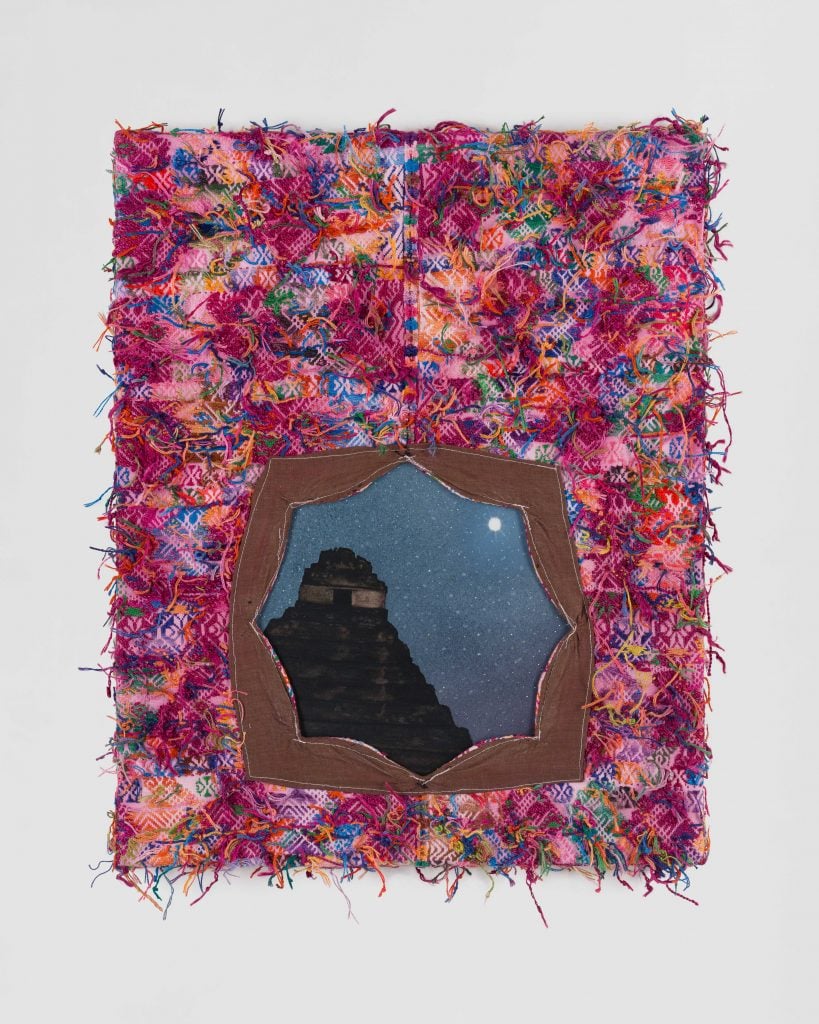
Nery Gabriel Lemus, They Got Pyramids Where I’m From (2024). Courtesy of the artist and Charlie James Gallery, Los Angeles. © 2024 Nery Gabriel Lemus; Photo © 2024 Yubo Dong @ofphotostudio.
In extremely detailed watercolors, L.A.-based Nery Gabriel Lemus conjures distinct moments in time, capturing the tilt of a beloved dog’s head, the sheen of a glazed pot holding the spiky leaves of a red-tinged plant. The almost photographic quality of the works, all of which capture scenes or objects of domesticity in specifically Latinx interiors, is juxtaposed with found objects, often tapestries, that are affixed to the panels, creating a trompe l’oeil affect that begs for closer inspection. In works like On a Wing and a Prayer, They Got Pyramids Where I’m From, and A Gracious Welcome, traditional Guatemalan hupil—the colorful top portion of woven dress worn by Indigenous women—is juxtaposed with identifiable markers of Western culture: a pink leather belt, or strips from a hairy welcome mat found at the front stoop of houses all across suburbia. Like the medium of watercolor itself, used by the likes of John James Audubon to document “exotic” birds and locales, Lemus has reclaimed these objects, and the method of creating them.
“Karyn Lyons: The End of the Night” at Anat Ebgi
Through March 2, 2024
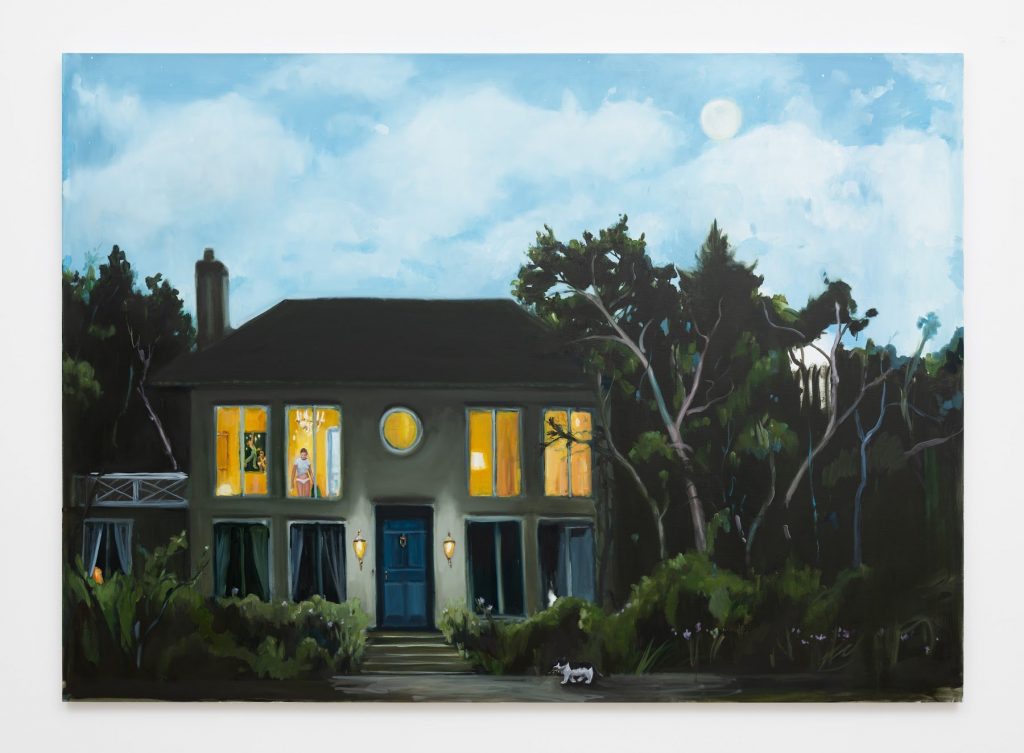
Karen Lyons, The Dominion of Night (2024). Courtesy of the artist and Anat Ebgi.
New York artist Karyn Lyons’ paintings have novelistic, even preppy coming-of-age quality in which adolescent girls exist suspended between solitary moments of pining and impassioned make-out scenes. In this, Lyons’ first solo exhibition with Anat Ebgi, a new series of paintings evokes the ferocity of such teenage emotions, while seemingly bidding them a fond farewell. One painting, The Dominion of Night (2024) is a nod to René Magritte’s The Empire of Light, pictures the exterior of a stately home at night, only the upstairs windows lights on. The curtains are provocatively drawn back. In one sense we can imagine this house as the soon-to-be adult protagonist’s home and her dollhouse at once, a space in which she tries on grown-up vices and pleasures—sneaking a cigarette or shots of Smirnoff while waiting, as though on a long summer day, for real-life to find her.
“Justin Williams: Synonym” at Robert’s Projects
Through March 9, 2024
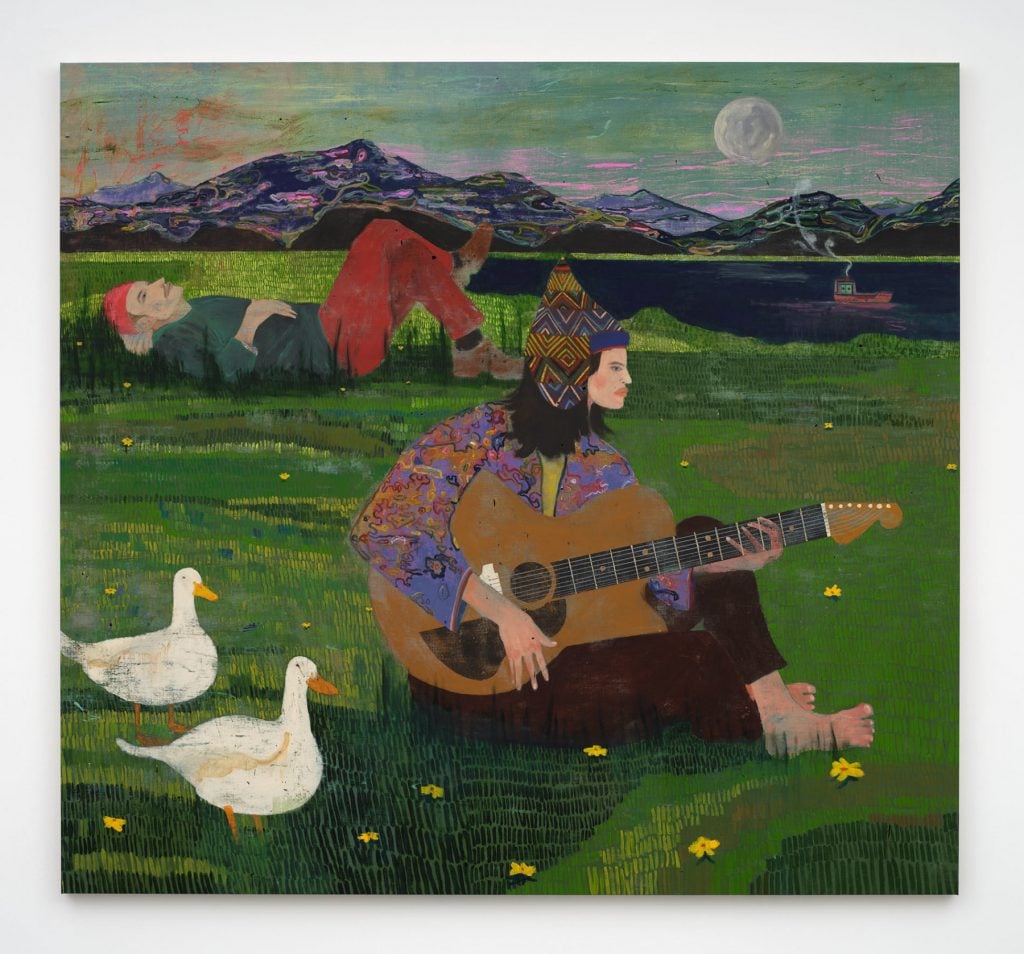
Justin Williams, I listened but only to sounds from the old boat, (2024). Courtesy of the artist and Robert’s Projects.
In “Synonym,” the Australian painter Justin Williams presents variated scenes that incite a mixed bag of feelings, namely that of familiarity and strangeness. Based in Santa Fe, New Mexico, with suburban Australia as his stomping ground and Egyptian ancestry in the fold, the folkloric motifs that appear in his canvases are notably hard to place. It’s as if you have stepped into a dream or someone’s else’s memory. Across his quotidian setting, a strongly figured cast of characters seem deeply enmeshed in these moments that are like candid scenes from a film where the volume is off. While it may be impossible to know what his characters are thinking as they wait together for a Bialetti to boil, or gather around a hookah by the bed or under skinny trees, there is something electric passing between them.
“Charles Hickey: The Bathers The Brushers” at Albertz Benda
Through April 13, 2024
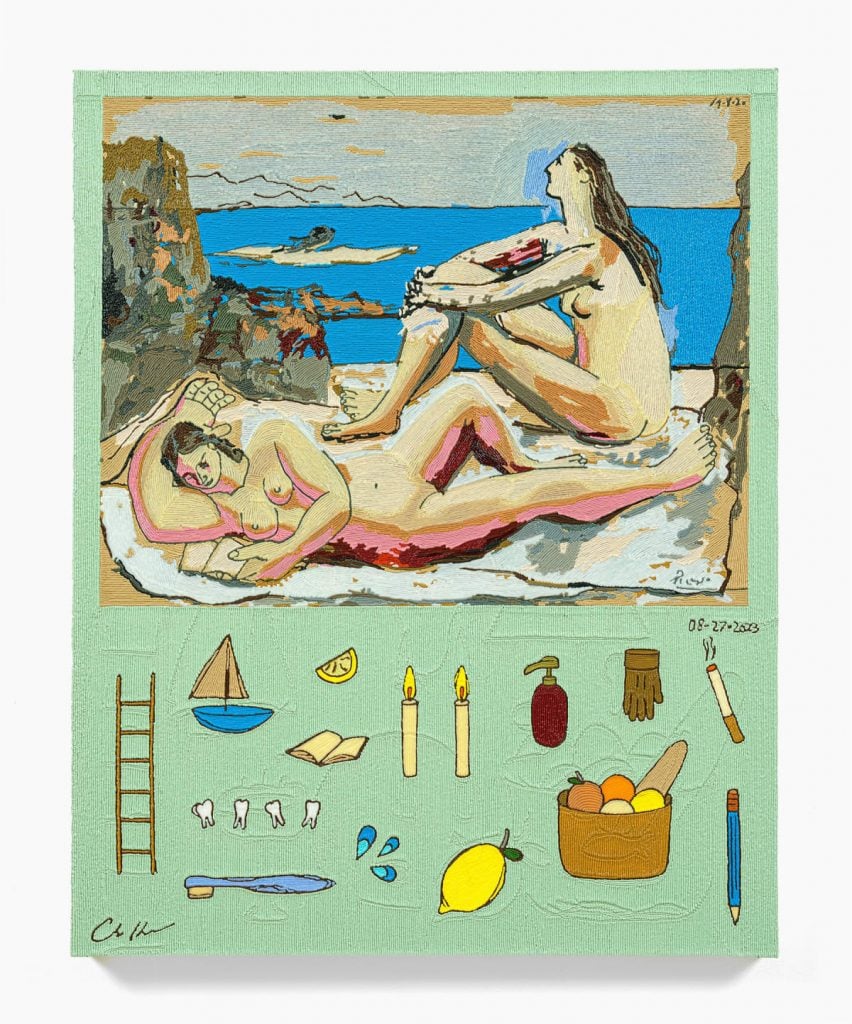
Charles Hickey, Clock Sail Basket (2023). Courtesy of the artist and Albertz Benda.
In Albertz Benda’s very unique exhibition space fittingly dubbed “The Bathroom,” Los Angeles-based artist Charles Hickey’s sculptures and canvases, depicting various objects that one might find in a real bathroom, but all of the pieces here are made of plastic. Hickey’s medium is essentially a handheld 3D printer in the form of a pen, functioning almost like a piping bag for icing, giving the canvases a textured, three-dimensional look, and replicas of shampoo, hand soap, toothpaste, and more, fully realized sculptures seemingly conjured by the deft flick of the tool. While the objects are clearly related to the show’s title, “The Bathers, The Brushers,” the paintings are more nuanced, referencing art historical gems like Cézanne’s The Bathers, Van Gogh’s Still Life of Oranges and Lemons with Blue Gloves, and Matisse’s Still Life with Blue Tablecloth. Is Hickey referring to hair and toothbrushes, or paint brushes? Perhaps brushes with greatness, as he reinterprets the great masters of still lifes, while he has chosen to use an ultra-contemporary method for his own artistic contributions.
“Ouattara Watts” at Karma
Through March 16, 2024
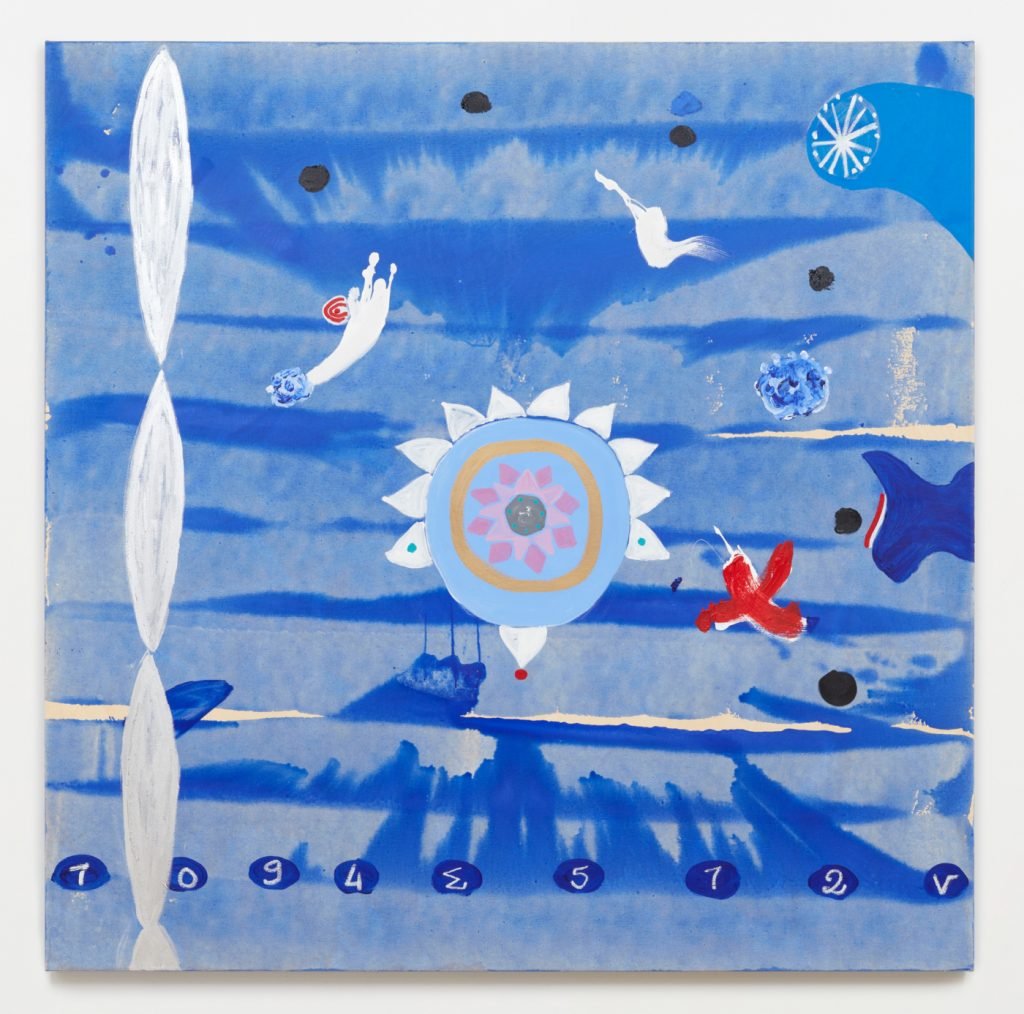
Ouattara Watts, Evolution 03 (2023). Courtesy of the artist and Karma, Los Angeles.
At Karma’s Los Angeles outpost, an exhibition of new paintings by the Abidjan-born, New York–based artist Ouattara Watts’s dynamic and luminous paintings take center stage. In his first-ever L.A. show, canvases embedded with the artist’s physical and immaterial experiences around the world come to bear in curious, engaging works. A specific and individual visual language including cosmological references, numbers, figures, and symbols, are informed by the artist’s global exposure to such diverse influences as the animist religion of the West African Senufo people, and the modernists he studied while at L’École Nationale Supérieure des Beaux-Arts in Paris. “I think universally…” the artist said, “about the history of the human soul. It’s not a history of clans, ethnic groups, or even artists, it’s what we can call the human condition.” In the vein of artists like Hilma af Klint and Jean-Michel Basquiat, beyond the specific and myriad references Watts is making, viewers can sense they are in the presence of something greater than themselves, even if they don’t know what it is.





